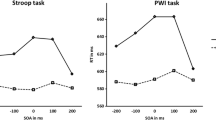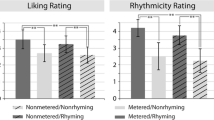Abstract
40 introductory psychology students, tested individually, listened to 4 diverse poetic selections. Each poem was classified as either high or low in “ornamentation” [shadowy imagery] and in “occupancy” [regularity of meter]. A third independent variable was a relaxed versus an involved set of listening instructions. Results were obtained on 3 dependent measures: (a) The Spellweaving Poetry Scale yielded an ornamentation X occupancy interaction; (b) poem duration estimation error yielded an ornamentation main effect and an ornamentation X occupancy interaction; (c) line recognition yielded main effects for ornamentation and occupancy. It was concluded, in contrast to some earlier views, that some aspect of ornamentation is probably the most important determinant of the spellweaving effect.
Similar content being viewed by others
References
ANONYMOUS. 1969. The effects of marijuana on consciousness. In C. T. Tart (Ed.), Altered states of consciousness. New York: Wiley. Pp. 335–355.
BARTLETT, F. C. 1932. Remembering. Cambridge, Eng.: Cambridge University Press.
BEAVER, J. C. 1968. A grammar of prosody. College English, 29, 310–321.
BLIGHT, J. G. 1973. A factor analytic study of “openness to non-rubricized experience” and its elucidation using the Spellweaving Poetry Scale. Paper presented at the annual meeting of the Eastern Psychological Association, Washington, D.C., May.
BRUNER, J. S. 1957. On perceptual readiness. Psychological Review, 64, 123–152.
CHATMAN, S. 1965. A theory of meter. The Hague: Mouton.
CHOMSKY, N. 1965. Aspects of the theory of syntax. Cambridge: Mit Press.
COLERIDGE, S. T. 1907. Biographia literaria. 2 Vols. (Ed. by J. Shawcross). Oxford: Clarendon.
DEESE, J. 1970. Psycholinguistics. Boston: Allyn & Bacon.
DEIKMAN, A. J. 1963. Experimental meditation. Journal of Nervous and Mental Disease, 136, 329–343.
FUSSELL, P. 1965. poetic meter and poetic form. New York: Random House.
GROSS, H. 1964. Soundandform in modernpoetry. Ann Arbor: University of Michigan Press.
GROSS, H. (Ed.) 1966. The structure of verse. New York: Fawcett.
HALLE, M., & KEYSER, S.J. 1966. Chaucer and the study of prosody. College English, 28, 187–219.
HALLE, M., & KEYSER, S. J. 1971. English stress: Its form, its growth, and its role in verse. New York: Harper & Row.
HERON, W., DOANE, B., & SCOTT, T. 1956. Visual disturbances after prolonged perceptual isolation. Canadian Journal of Psychology, 10, 13–18.
LOOMIS, L. 1942. Introduction to The Iliad. Roslyn, N.Y.: Black.
McGEOCH, J. A. 1942. The psychology of human learning. New York: Longmans.
MILLER, G. A., & ISARD, S. 1964. Free recall of self-embedded English sentences. Information and Control, 7, 292–303.
NEISSER, U. 1967. Cognitive psychology. New York: Appleton-Century-Crofts.
NOWLIS, D. P., & KAMIYA, J. 1970. The control of Eeg alpha rhythms through auditory feedback and the associated mental activity. Psychophysiology, 6, 476–484.
ORNE, M. T. 1962. On the social psychology of the psychological experiment: With particular reference to demand characteristics arid their implications. American Psychologist, 17, 776–783.
RICHARDS, I. A. 1928. Principles of literary criticism. New York: Harcourt, Brace.
SHAPIRO, K., & BEUM, R. 1965. A prosody handbood. New York: Harper & Row.
SHOR, R. E. 1959. Hypnosis and the concept of the generalized reality orientation. American Journal of Psychotherapy, 13, 582–602.
SHOR, R. E. 1962. Three dimensions of hypnotic depth. International Journal of Clinical and Experimental Hypnosis, 10, 23–38.
SHOR, R. E. 1970. The three factor theory of hypnosis as applied to the book reading fantasy and to the concept of suggestion. International Journal of Clinical and Experimental Hypnosis, 18, 89–98.
SINGER, J. L. 1966. Daydreaming. New York: Random House.
SNYDER, E. D. 1930. Hypnotic poetry: A study of trance-inducing technique in certain poems and its literary significance. Philadelphia: University of Pennsylvania Press.
STACE, W. T. 1960. The teachings of the mystics. New York: NAL.
WINER, B.J. 1962. Statistical principles in experimental design. New York: McGraw-Hill.
Author information
Authors and Affiliations
Additional information
We wish to thank Dr. Ronald E. Shor for his valuable assistance in carrying out this study.
Rights and permissions
About this article
Cite this article
Blight, J.G., Huggard, D. The Spellweaving Poetry Phenomenon: Exploratory Attempts to Discover its Causes and Measure its Effects. Psychol Rec 25, 509–524 (1975). https://doi.org/10.1007/BF03394343
Published:
Issue Date:
DOI: https://doi.org/10.1007/BF03394343




